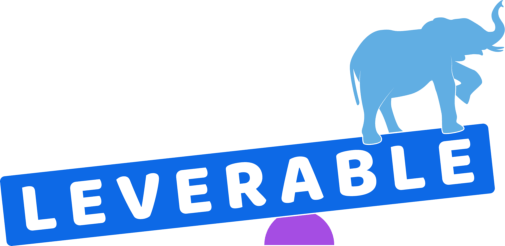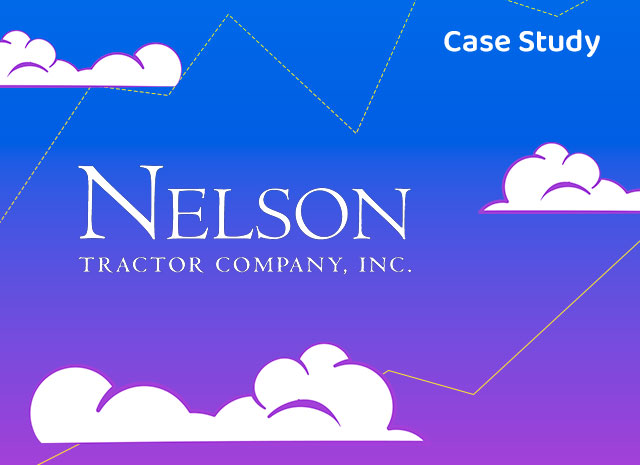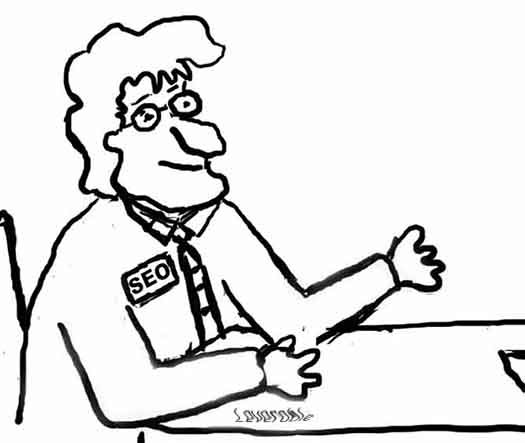Every company’s website goes through critical stages when SEO makes the difference between success and failure.
Forewarned is forearmed. It’s time to understand the most critical times to have your SEO consultant seated at the table with you. I believe they are:
1. New site development
2. Website launch
3. Site move
4. Redesign
5. CMS change
6. Domain change
7. Post hacking attack
8. Unknown drop in visits
9. Google updates
“They say, timing is everything. But then they say, there is never a perfect time for anything.” – Anthony Liccione
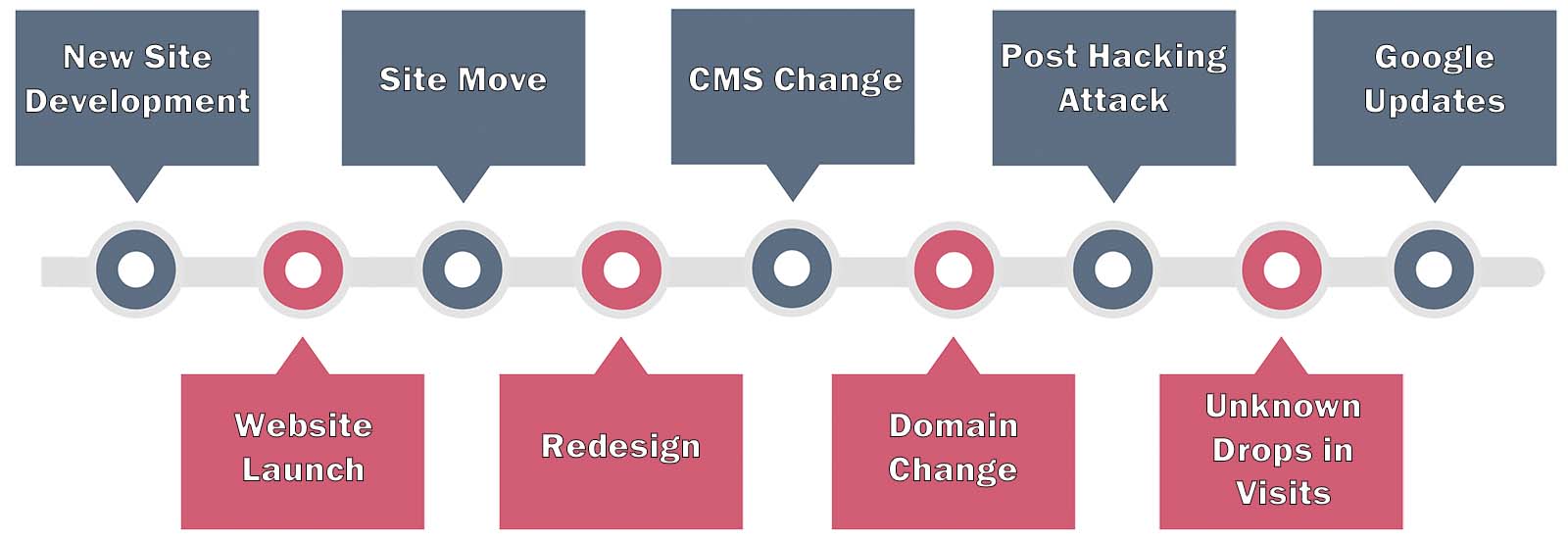
New Site Development
Why invest in a website? To reach your strategic goals: more awareness, more sales, more customers.
If this is the case, then who on the development team is responsible for achieving these goals? Your designer? Nope. The project manager? Nah. Maybe your web developer? Wrong again.
Unless you’re doing it as a hobby, a seasoned SEO professional should look at every major decision made during the development process.
Conversely, every single idea implemented without SEO in mind takes you a step closer toward having spent money on a website with no results to show for the effort a year later.
The greatest victories in the dev stage are simply stopping bad ideas from taking root.
Bad ideas like these:
- A chaotic site structure with little or no forethought for SEO or UX
- Bloated code or a graphics-dependent layout that slows page speed
- Disregard for on-page SEO elements
- Repeated or missing meta data
- Failure to connect the content with the design
So many ideas that look good on paper end up dragging a site down so far it hurts. Sometimes, as the famous quote from WarGames goes,
“The only winning move is not to play.”
The most important time to do SEO is at the beginning.
Website Launch
I started my first SEO gig at an agency and was given the responsibility of growing the organic performance of a small lead gen site. I kept wondering why the site just seemed to die after the launch. The SERPs didn’t look right. I finally figured out that the developer had made changes and uploaded the dev site robots.txt file that blocked crawlers to the live site. That’s a classic. And I bet it’s happened to you too?
I just needed to remove the oh-so-important trailing slash:
User-agent: *
Disallow: /
There are plenty of other SEO issues that can hose up your site launch.
An SEO consultant has to make sure no technical issues slip through the cracks—because developers with the best intentions can get it wrong.
Here are some ugly issues that I’ve seen surface after a launch:
- Missing or incorrectly built sitemap
- Structured data markup errors
- Mobile-specific SEO issues
- Misused status codes
- Broken links
- Canonical URL issues
And I haven’t even scratched the surface with these. In addition, it’s absolutely essential to develop a strategy to help a website gain traction and get its first steady flow of visitors from organic search (give SEOs four months to a year to see results).
Most people don’t sit down and map out their organic search strategy before their site launches. If you want results, best do it while the domain is in cryogenic freeze.
Site Move
Any drastic, significant changes to your website have the potential to be as devastating to your SEO as cashing out your 401k after a market crash. And under no circumstances should this be entrusted to amateurs.
Migrating your website to a new host or content distribution network (CDN) falls into that category.
An SEO expert makes sure the transition goes smoothly and prevents or mitigates potential traffic drops from the move.
When things go south, poor planning and poor implementation are at the heart of the problem.
The most common and impactful mistakes I see with site moves are with redirects: doing them incorrectly or not at all.
Redesign
While switching hosting providers may be a relatively benign process, revamping a website with a new theme, media, code, and content changes without tanking visits and revenue is an art form in itself.
For an SEO consultant, a redesign might feel like walking a minefield. In the pitch-black woods. Blindfolded.
So many things must be factored in to prevent risks. One thing that I’ve noticed a lot lately in the design process is the decision to replace the copy on pages that perform well in organic search. Another is switching internal anchor text that is working perfectly well to an altogether different phrase.
As an example of a redesign gone wrong, a blog covering acne problems underwent a major redesign, changing the WordPress theme and radically altering the site structure without taking any special precautions regarding SEO.
The Mariana Trench on the graph of this site’s activity below shows how unbelievably devastating revamps can truly be. Notice how the website failed to recover almost two years after the redesign—even with the superior content of the new design which easily outperformed the competition for a myriad of keywords.
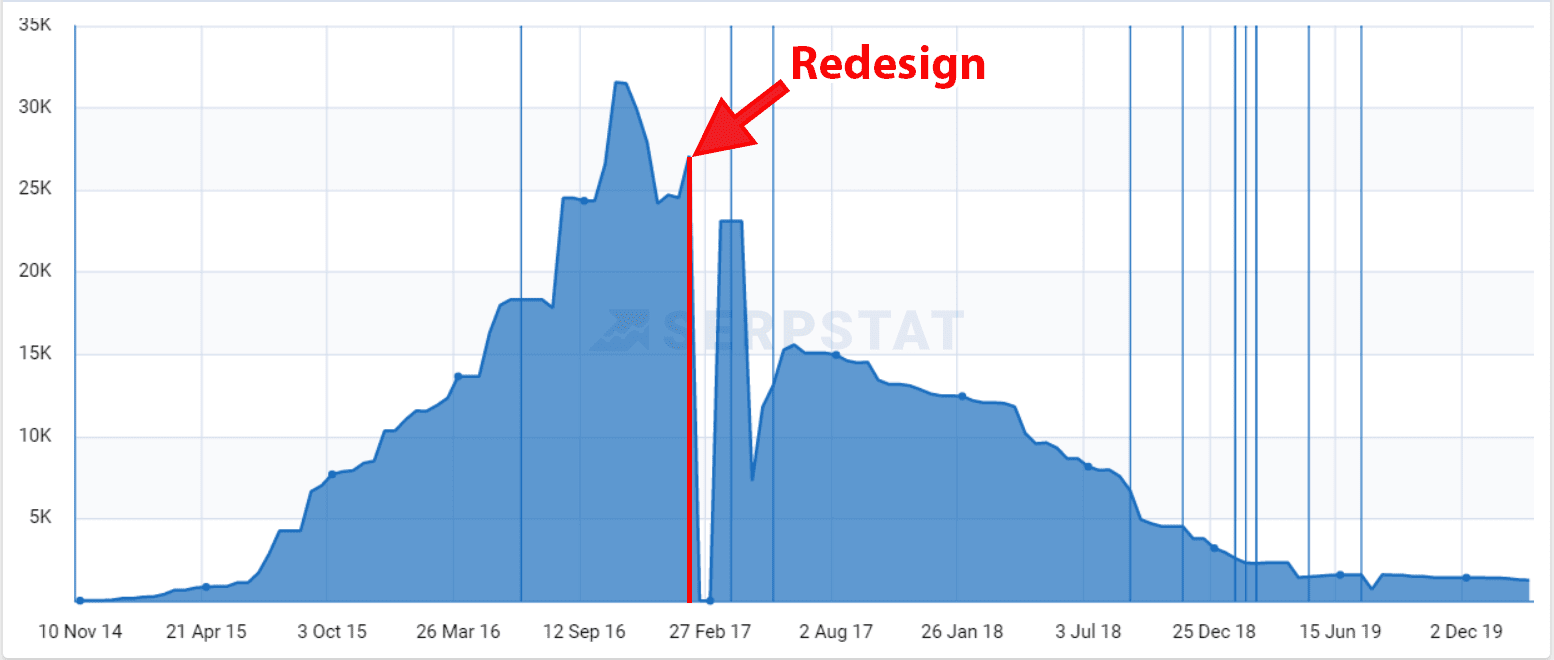
John Mueller of Google says the main things to look for when doing a “revamp” are:
- That the URLs stay the same as much as possible so that you don’t change the URL structure.
- That the internal linking stays the same as much as possible.
- That the content and the layout on the pages stays the same as much as possible.
A knowledgeable SEO consultant can help you maneuver these, and other risks involved in your site redesign.
CMS Change
Recently an ecommerce business owner contacted us to ask for some forensic SEO to determine the cause of a sudden drop in organic visits after moving to Shopify. We were able to identify about 10 issues that stopped the bleeding and got him back on track. Misredirected or unredirected URLs were a large part of the culprit.
CMS migration is a necessary evil for companies, especially when going through tremendous growth.
However, the URLs, code, and structure affected by such a move can cause crawlability issues, followed by drops in rankings.
You need an SEO consultant to recover any losses fast and do quality assurance during the site move.
Domain Change
The best top-level domains have already become high-value digital real estate, some of which cost more than a mansion. So, whenever a small business gets its hands on something really exceptional or undergoes a rebranding, they decide to take the leap.
The chief task of an SEO consultant is to facilitate a smooth transition of the link flow, rankings, and visits to the new domain using the right redirects and addressing technical SEO issues that arise.
It’s not as simple to pull off as it sounds, and the ramifications may be truly devastating.
One of the biggest SEO blunders in history showcases how a domain name change can go wrong.
Back in 2009, Toys“R”Us bought the domain “toys.com” for $5.1 million in its efforts to win the war for being the biggest player in the toy industry. The plan was to channel the traffic from “toys.com” to “toysrus.com.”
But because of the wrong redirects being in place, the newly purchased website lost all the rankings and was de-indexed by Google.
An experienced SEO consultant steers you clear of such unforced errors.
Post Hacking Attack
With about 30,000 websites being hacked every day, nobody is truly safe from security breaches. This is an issue that search engines treat with utmost seriousness, pushing for severe penalties for those who fail to identify and tackle a breach on the spot. And with good reason. Google never wants to send a visitor to a hacked site.
Hacking attacks can do any of the following damage and more:
- URL injection (creating new pages with spammy content or links)
- Content injection (adding spammy content or links on the existing pages)
- Code injection (adding malicious code to your pages)
This graph reveals the effect of a website losing its hard-won organic traffic as a result of being infested with spammy pages completely unbeknownst to the owners:

Regular technical SEO audits help spot security breaches, whereas an SEO consultant does the damage control to cushion the blow and develops a plan to recover the losses.
Unknown Drop in Visits
Sudden, mysterious drops in website visits can come out of nowhere. And the issue perpetuates itself because the owner usually has no idea whatsoever regarding the cause of the drop in the first place.
There’s a myriad of things that can cause website visits to come crashing down. These are the most common culprits:
- Search engine penalties
- Technical SEO issues
- Algorithm updates
- Tracking issues
Zig Ziglar used to say, “If you aim at nothing, you will hit it every time.”
In 2011, retailer JCPenney got busted in a New York Times story for using paid links and lost most of its rankings for 90 days.
JCPenney managed to recover, but a similar case would be the kiss of death for almost any small ecommerce website out there. Theoretically, no one is “too big to fail.”
A battle-hardened SEO consultant will get to the bottom of the problem fast and determine the best course of action.
Google Updates
Leverable took on a couple of small business clients who saw rankings and visitors drop off around the time of Google Penguin. We were able to clean up their backlink profile, do some disavowing and other things to get them back up. It took a while but felt like a great victory. I was stoked to have made such an impact on their businesses.
Every now and then, search engines roll out major updates that completely redefine the rules of the game. In other words, what works today may lead to your downfall tomorrow.
The failure to adapt your SEO strategy after a big update can cost you months or longer to recover.
Every SEO consultant worth their salt must keep their finger on the pulse of recent updates to reverse the course of the ship should they catch a whiff of the impending disaster.
“An ounce of prevention is worth a pound of cure.” – Benjamin Franklin
To Summarize
In review, these are the critical times when SEO becomes a matter of life-or-death for a business:
- New site development
- Website launch
- Site move
- Redesign
- CMS change
- Domain change
- Post hacking attack
- Unknown drop in visits
- Google updates
If you can’t have an SEO pro safeguarding and strategizing at all times, at least have him there during these key times that occur in the life of a typical website.
